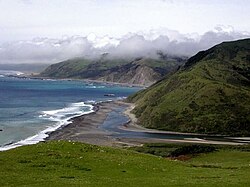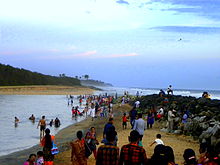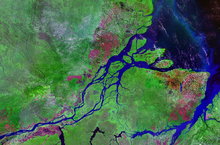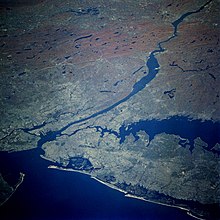Estuary
| Marine habitats |
|---|
 |
|
An estuary is a partially enclosed coastal body of brackish water with one or more rivers or streams flowing into it, and with a free connection to the open sea.[1] Estuaries form a transition zone between river environments and maritime environments and are an example of an ecotone. Estuaries are subject both to marine influences such as tides, waves, and the influx of saline water and to riverine influences such as flows of freshwater and sediment. The mixing of seawater and freshwater provides high levels of nutrients both in the water column and in sediment, making estuaries among the most productive natural habitats in the world.[2]
Most existing estuaries formed during the Holocene epoch with the flooding of river-eroded or glacially scoured valleys when the sea level began to rise about 10,000–12,000 years ago.[3] Estuaries are typically classified according to their geomorphological features or to water-circulation patterns. They can have many different names, such as bays, harbors, lagoons, inlets, or sounds, although some of these water bodies do not strictly meet the above definition of an estuary and could be fully saline.
Many estuaries suffer degeneration from a variety of factors including soil erosion, deforestation, overgrazing, overfishing and the filling of wetlands. Eutrophication may lead to excessive nutrients from sewage and animal wastes; pollutants including heavy metals, polychlorinated biphenyls, radionuclides and hydrocarbons from sewage inputs; and diking or damming for flood control or water diversion.[3][4]
Definition[]







The word "estuary" is derived from the Latin word aestuarium meaning tidal inlet of the sea, which in itself is derived from the term aestus, meaning tide. There have been many definitions proposed to describe an estuary. The most widely accepted definition is: "a semi-enclosed coastal body of water, which has a free connection with the open sea, and within which seawater is measurably diluted with freshwater derived from land drainage".[1] However, this definition excludes a number of coastal water bodies such as coastal lagoons and brackish seas.
A more comprehensive definition of an estuary is "a semi-enclosed body of water connected to the sea as far as the tidal limit or the salt intrusion limit and receiving freshwater runoff; however the freshwater inflow may not be perennial, the connection to the sea may be closed for part of the year and tidal influence may be negligible".[3] This broad definition also includes fjords, lagoons, river mouths, and tidal creeks. An estuary is a dynamic ecosystem having a connection to the open sea through which the sea water enters with the rhythm of the tides. The seawater entering the estuary is diluted by the fresh water flowing from rivers and streams. The pattern of dilution varies between different estuaries and depends on the volume of freshwater, the tidal range, and the extent of evaporation of the water in the estuary.[2]
Classification based on geomorphology[]
Drowned river valleys[]
Drowned river valleys are also known as coastal plain estuaries. In places where the sea level is rising relative to the land, sea water progressively penetrates into river valleys and the topography of the estuary remains similar to that of a river valley. This is the most common type of estuary in temperate climates. Well-studied estuaries include the Severn Estuary in the United Kingdom and the Ems Dollard along the Dutch-German border.
The width-to-depth ratio of these estuaries is typically large, appearing wedge-shaped (in cross-section) in the inner part and broadening and deepening seaward. Water depths rarely exceed 30 m (100 ft). Examples of this type of estuary in the U.S. are the Hudson River, Chesapeake Bay, and Delaware Bay along the Mid-Atlantic coast, and Galveston Bay and Tampa Bay along the Gulf Coast.[5]
Lagoon-type or bar-built[]
Bar-built estuaries are found in a place where the deposition of sediment has kept pace with rising sea levels so that the estuaries are shallow and separated from the sea by sand spits or barrier islands. They are relatively common in tropical and subtropical locations.
These estuaries are semi-isolated from ocean waters by barrier beaches (barrier islands and barrier spits). Formation of barrier beaches partially encloses the estuary, with only narrow inlets allowing contact with the ocean waters. Bar-built estuaries typically develop on gently sloping plains located along tectonically stable edges of continents and marginal sea coasts. They are extensive along the Atlantic and Gulf coasts of the U.S. in areas with active coastal deposition of sediments and where tidal ranges are less than 4 m (13 ft). The barrier beaches that enclose bar-built estuaries have been developed in several ways:
- building up of offshore bars by wave action, in which sand from the seafloor is deposited in elongated bars parallel to the shoreline,
- reworking of sediment discharge from rivers by a wave, current, and wind action into beaches, overwash flats, and dunes,
- engulfment of mainland beach ridges (ridges developed from the erosion of coastal plain sediments around 5000 years ago) due to sea level rise and resulting in the breaching of the ridges and flooding of the coastal lowlands, forming shallow lagoons, and
- elongation of barrier spits from the erosion of headlands due to the action of longshore currents, with the spits growing in the direction of the littoral drift.[citation needed]
Fjord-type[]
Fjords were formed where Pleistocene glaciers deepened and widened existing river valleys so that they become U-shaped in cross-sections. At their mouths there are typically rocks, bars or sills of glacial deposits, which have the effects of modifying the estuarine circulation.
Fjord-type estuaries are formed in deeply eroded valleys formed by glaciers. These U-shaped estuaries typically have steep sides, rock bottoms, and underwater sills contoured by glacial movement. The estuary is shallowest at its mouth, where terminal glacial moraines or rock bars form sills that restrict water flow. In the upper reaches of the estuary, the depth can exceed 300 m (1,000 ft). The width-to-depth ratio is generally small. In estuaries with very shallow sills, tidal oscillations only affect the water down to the depth of the sill, and the waters deeper than that may remain stagnant for a very long time, so there is only an occasional exchange of the deep water of the estuary with the ocean. If the sill depth is deep, water circulation is less restricted, and there is a slow but steady exchange of water between the estuary and the ocean. Fjord-type estuaries can be found along the coasts of Alaska, the Puget Sound region of western Washington state, British Columbia, eastern Canada, Greenland, Iceland, New Zealand, and Norway.
Tectonically produced[]
These estuaries are formed by subsidence or land cut off from the ocean by land movement associated with faulting, volcanoes, and landslides. Inundation from eustatic sea-level rise during the Holocene Epoch has also contributed to the formation of these estuaries. There are only a small number of tectonically produced estuaries; one example is the San Francisco Bay, which was formed by the crustal movements of the San Andreas fault system causing the inundation of the lower reaches of the Sacramento and San Joaquin rivers.[6]
Classification based on water circulation[]
Salt wedge[]
In this type of estuary, river output greatly exceeds marine input and tidal effects have minor importance. Freshwater floats on top of the seawater in a layer that gradually thins as it moves seaward. The denser seawater moves landward along the bottom of the estuary, forming a wedge-shaped layer that is thinner as it approaches land. As a velocity difference develops between the two layers, shear forces generate internal waves at the interface, mixing the seawater upward with the freshwater. An example of a salt wedge estuary is the Mississippi River.[6]
Partially mixed[]
As tidal forcing increases, river output becomes less than the marine input. Here, current induced turbulence causes mixing of the whole water column such that salinity varies more longitudinally rather than vertically, leading to a moderately stratified condition. Examples include the Chesapeake Bay and Narragansett Bay.[6]
Well-mixed[]
Tidal mixing forces exceed river output, resulting in a well-mixed water column and the disappearance of the vertical salinity gradient. The freshwater-seawater boundary is eliminated due to the intense turbulent mixing and eddy effects. The lower reaches of Delaware Bay and the Raritan River in New Jersey are examples of vertically homogenous estuaries.[6]
Inverse[]
Inverse estuaries occur in dry climates where evaporation greatly exceeds the inflow of freshwater. A salinity maximum zone is formed, and both riverine and oceanic water flow close to the surface towards this zone.[7] This water is pushed downward and spreads along the bottom in both the seaward and landward direction.[3] An example of an inverse estuary is Spencer Gulf, South Australia.[8]
Intermittent[]
Estuary type varies dramatically depending on freshwater input, and is capable of changing from a wholly marine embayment to any of the other estuary types.[9][10]
Physiochemical variation[]
The most important variable characteristics of estuary water are the concentration of dissolved oxygen, salinity and sediment load. There is extreme spatial variability in salinity, with a range of near-zero at the tidal limit of tributary rivers to 3.4% at the estuary mouth. At any one point, the salinity will vary considerably over time and seasons, making it a harsh environment for organisms. Sediment often settles in intertidal mudflats which are extremely difficult to colonize. No points of attachment exist for algae, so vegetation based habitat is not established.[clarification needed] Sediment can also clog feeding and respiratory structures of species, and special adaptations exist within mudflat species to cope with this problem. Lastly, dissolved oxygen variation can cause problems for life forms. Nutrient-rich sediment from man-made sources can promote primary production life cycles, perhaps leading to eventual decay removing the dissolved oxygen from the water; thus hypoxic or anoxic zones can develop.[11]
Implications for marine life[]
Estuaries are incredibly dynamic systems, where temperature, salinity, turbidity, depth and flow all change daily in response to the tides. This dynamism makes estuaries highly productive habitats, but also make it difficult for many species to survive year-round. As a result, estuaries large and small experience strong seasonal variation in their fish communities.[12] In winter, the fish community is dominated by hardy marine residents, and in summer a variety of marine and anadromous fishes move into and out of estuaries, capitalizing on their high productivity.[13] Estuaries provide critical habitat to a variety of species that rely on estuaries for life-cycle completion. Pacific Herring (Clupea pallasii) are known to lay their eggs in estuaries and bays, surfperch give birth in estuaries, juvenile flatfish and rockfish migrate to estuaries to rear, and anadromous salmonids and lampreys use estuaries as migration corridors.[14] Also, migratory bird populations, such as the black-tailed godwit,[15] rely on estuaries.
Two of the main challenges of estuarine life are the variability in salinity and sedimentation. Many species of fish and invertebrates have various methods to control or conform to the shifts in salt concentrations and are termed osmoconformers and osmoregulators. Many animals also burrow to avoid predation and to live in a more stable sedimental environment. However, large numbers of bacteria are found within the sediment which has a very high oxygen demand. This reduces the levels of oxygen within the sediment often resulting in partially anoxic conditions, which can be further exacerbated by limited water flux.
Phytoplankton are key primary producers in estuaries. They move with the water bodies and can be flushed in and out with the tides. Their productivity is largely dependent upon the turbidity of the water. The main phytoplankton present is diatoms and dinoflagellates which are abundant in the sediment.
It is important to remember that a primary source of food for many organisms on estuaries, including bacteria, is detritus from the settlement of the sedimentation.
Human impact[]
Of the thirty-two largest cities in the world in the early 1990s, twenty-two were located on estuaries.[16]
As ecosystems, estuaries are under threat from human activities such as pollution and overfishing. They are also threatened by sewage, coastal settlement, land clearance and much more. Estuaries are affected by events far upstream, and concentrate materials such as pollutants and sediments.[17] Land run-off and industrial, agricultural, and domestic waste enter rivers and are discharged into estuaries. Contaminants can be introduced which do not disintegrate rapidly in the marine environment, such as plastics, pesticides, furans, dioxins, phenols and heavy metals.
Such toxins can accumulate in the tissues of many species of aquatic life in a process called bioaccumulation. They also accumulate in benthic environments, such as estuaries and bay muds: a geological record of human activities of the last century. The elemental composition of biofilm reflect areas of the estuary impacted by human activities, and over time may shift the basic composition of the ecosystem, and the reversible or irreversible changes in the abiotic and biotic parts of the systems from the bottom up.[18]
For example, Chinese and Russian industrial pollution, such as phenols and heavy metals, has devastated fish stocks in the Amur River and damaged its estuary soil.[19]
Estuaries tend to be naturally eutrophic because land runoff discharges nutrients into estuaries. With human activities, land run-off also now includes the many chemicals used as fertilizers in agriculture as well as waste from livestock and humans. Excess oxygen-depleting chemicals in the water can lead to hypoxia and the creation of dead zones.[20] This can result in reductions in water quality, fish, and other animal populations. Overfishing also occurs. Chesapeake Bay once had a flourishing oyster population that has been almost wiped out by overfishing. Oysters filter these pollutants, and either eat them or shape them into small packets that are deposited on the bottom where they are harmless. Historically the oysters filtered the estuary's entire water volume of excess nutrients every three or four days. Today that process takes almost a year,[21] and sediment, nutrients, and algae can cause problems in local waters.
Examples[]
Africa[]
- Orange River Estuary
- Lake St Lucia Estuary
Asia[]
- Gulf of Ob Estuary
- Yenisei Gulf Estuary
- Puerto Princesa Underground River
- Hàn River Estuary
- Kraburi River Estuary[22]
- Waeru River Estuary of Chanthaburi Province[23]
- Dawei River Estuary[24]
- Naf River Estuary[25]
- Meghna River Estuary[26]
Europe[]
- The Gironde
- Golden Horn
- The Humber
- Severn Estuary
- Shannon Estuary
- Thames Estuary
- The Wash
- Unterelbe
- Western Scheldt
North America[]
- Albemarle Sound including Outer Banks of North Carolina
- Chesapeake Bay including Hampton Roads
- Columbia River Estuary
- Delaware Bay
- Drake's Estero
- East River
- Estuary of Saint Lawrence
- Fraser River
- Galveston Bay
- Great Bay
- Indian River Lagoon
- Laguna Madre
- Lake Borgne
- Lake Merritt
- Lake Pontchartrain
- Long Island Sound
- Mobile Bay
- Narragansett Bay
- Newport Back Bay
- New York-New Jersey Harbor
- Puget Sound
- Pamlico Sound including the Outer Banks of North Carolina
- San Francisco Bay
- Tampa Bay
Oceania[]
- Gippsland Lakes
- Port Jackson (Sydney Harbour)
- Spencer Gulf[8]
South America[]
- Amazon River[27]
- Iguape-Cananéia-Paranaguá estuary lagoon complex
- Lagoa dos Patos and Lagoon Mirim
- Rio de la Plata
See also[]
- Bay mud – Type of soil formed by sedimentation in estuaries
- Beaches in estuaries and bays – Type of beaches
- Coastal and Estuarine Research Federation
- Estuarine acidification
- Estuarine fish
- Firth – Scottish word used for various coastal inlets and straits
- Freshwater inflow
- Liman – Landform, formed at the mouth of a river where flow is blocked by a bar of sediments
- List of estuaries of England – A list of estuaries in England
- List of estuaries of South Africa
- List of waterways – List of navigable rivers, canals, estuaries, lakes, and firths
- National Estuarine Research Reserve – Network of 29 protected areas in the US
- Region of freshwater influence – Regions where rivers debouch into estuaries and coastal shelf seas where the currents patterns are governed by density differences between salt sea water and fresh river water
- River delta – Silt deposition landform at the mouth of a river
- Shell growth in estuaries
- Tidal bore – A water wave traveling upstream a river or narrow bay because of an incoming tide
- Tidal prism – Volume of water in an estuary or inlet between mean high tide and mean low tide
- Wetland – Land area that is permanently or seasonally saturated with water
References[]
- ^ Jump up to: a b Pritchard, D. W. (1967). "What is an estuary: physical viewpoint". In Lauf, G. H. (ed.). Estuaries. A.A.A.S. Publ. 83. Washington, DC. pp. 3–5. hdl:1969.3/24383.
- ^ Jump up to: a b McLusky, D. S.; Elliott, M. (2004). The Estuarine Ecosystem: Ecology, Threats and Management. New York: Oxford University Press. ISBN 978-0-19-852508-0.
- ^ Jump up to: a b c d Wolanski, E. (2007). Estuarine Ecohydrology. Amsterdam: Elsevier. ISBN 978-0-444-53066-0.
- ^ Silva, Sergio; Lowry, Maran; Macaya-Solis, Consuelo; Byatt, Barry; Lucas, Martyn C. (2017). "Can navigation locks be used to help migratory fishes with poor swimming performance pass tidal barrages? A test with lampreys". Ecological Engineering. 102: 291–302. doi:10.1016/j.ecoleng.2017.02.027.
- ^ Kunneke, J. T.; Palik, T. F. (1984). "Tampa Bay environmental atlas" (PDF). U.S. Fish Wildl. Serv. Biol. Rep. 85 (15): 3. Retrieved January 12, 2010.
- ^ Jump up to: a b c d Kennish, M. J. (1986). Ecology of Estuaries. Volume I: Physical and Chemical Aspects. Boca Raton, FL: CRC Press. ISBN 978-0-8493-5892-0.
- ^ Wolanski, E. (1986). "An evaporation-driven salinity maximum zone in Australian tropical estuaries". Estuarine, Coastal and Shelf Science. 22 (4): 415–424. Bibcode:1986ECSS...22..415W. doi:10.1016/0272-7714(86)90065-X.
- ^ Jump up to: a b Gostin, V. & Hall, S.M. (2014): Spencer Gulf: Geological setting and evolution. In: Natural History of Spencer Gulf. Royal Society of South Australia Inc. p. 21. ISBN 9780959662764
- ^ Tomczak, M. (2000). "Oceanography Notes Ch. 12: Estuaries". Archived from the original on 7 December 2006. Retrieved 30 November 2006.
- ^ Day, J. H. (1981). Estuarine Ecology. Rotterdam: A. A. Balkema. ISBN 978-90-6191-205-7.
- ^ Kaiser; et al. (2005). Marine Ecology. Processes, Systems and Impacts. New York: Oxford University Press. ISBN 978-0199249756.
- ^ Osborn, Katherine (December 2017). Seasonal fish and invertebrate communities in three northern California estuaries (M.S. thesis). Humboldt State University.
- ^ Allen, Larry G. (1982). "Seasonal abundance, composition and productivity of the littoral fish assemblage in Upper Newport Bay, California" (PDF). Fishery Bulletin. 80 (4): 769–790.
- ^ Gillanders, BM; Able, KW; Brown, JA; Eggleston, DB; Sheridan, PF (2003). "Evidence of connectivity between juvenile and adult habitats for mobile marine fauna: An important component of nurseries". Marine Ecology Progress Series. 247: 281–295. Bibcode:2003MEPS..247..281G. doi:10.3354/meps247281. JSTOR 24866466.
- ^ Gill, Jennifer A.; Norris, Ken; Potts, Peter M.; Gunnarsson, Tómas Grétar; Atkinson, Philip W.; Sutherland, William J. (2001). "The buffer effect and large-scale population regulation in migratory birds". Nature. 412 (6845): 436–438. Bibcode:2001Natur.412..436G. doi:10.1038/35086568. PMID 11473317. S2CID 4308197.
- ^ Ross, D. A. (1995). Introduction to Oceanography. New York: Harper Collins College Publishers. ISBN 978-0-673-46938-0.
- ^ Branch, George (1999). "Estuarine vulnerability and ecological impacts". Trends in Ecology & Evolution. 14 (12): 499. doi:10.1016/S0169-5347(99)01732-2.
- ^ García-Alonso, J.; Lercari, D.; Araujo, B.F.; Almeida, M.G.; Rezende, C.E. (2017). "Total and extractable elemental composition of the intertidal estuarine biofilm of the Río de la Plata: Disentangling natural and anthropogenic influences". Estuarine, Coastal and Shelf Science. 187: 53–61. Bibcode:2017ECSS..187...53G. doi:10.1016/j.ecss.2016.12.018.
- ^ "Indigenous Peoples of the Russian North, Siberia and Far East: Nivkh" by Arctic Network for the Support of the Indigenous Peoples of the Russian Arctic
- ^ Gerlach, Sebastian A. (1981). Marine Pollution: Diagnosis and Therapy. Berlin: Springer. ISBN 978-0387109404.
- ^ "Oyster Reefs: Ecological importance". US National Oceanic and Atmospheric Administration. Archived from the original on October 3, 2008. Retrieved 2008-01-16.
- ^ "สัณฐานชายฝั่ง - ระบบฐานข้อมูลทรัพยากรทางทะเลและชายฝั่ง กรมทรัพยากรทางทะเลและชายฝั่ง". km.dmcr.go.th.
- ^ "พื้นที่ชุ่มน้ำในประเทศไทย". wetland.onep.go.th.
- ^ "Dawei(Tavoy)". myanmarholiday.com.
- ^ Noman, Md. Abu; Mamunur, Rashid; Islam, M. Shahanul; Hossain, M. Belal (2018). "Spatial and seasonal distribution of Intertidal Macrobenthos with their biomass and functional feeding guilds in the Naf River estuary, Bangladesh". Journal of Oceanology and Limnology. 37 (3): 1010–1023. Bibcode:2018JOL...tmp...33N. doi:10.1007/s00343-019-8063-7. S2CID 92734488.
- ^ Jakobsen, F.; Azam, M.H.; Mahboob-Ul-Kabir, M. (2002). "Residual Flow in the Meghna Estuary on the Coastline of Bangladesh". Estuarine, Coastal and Shelf Science. 55 (4): 587–597. Bibcode:2002ECSS...55..587J. doi:10.1006/ecss.2001.0929.
- ^ "The Amazon River Estuary". etai's web.
External links[]
| Wikimedia Commons has media related to Estuaries. |
| Look up estuary in Wiktionary, the free dictionary. |
- Animated documentary on Chesapeake Bay NOAA.
- "Habitats: Estuaries – Characteristics". www.onr.navy.mil. Archived from the original on 2009-05-17. Retrieved 2009-11-17.
- The Estuary Guide (Based on experience and R&D within the UK)
- Estuaries
- Geodesy
- Coastal geography
- Fishing and the environment
- Coastal and oceanic landforms
- Bodies of water
- Aquatic ecology





